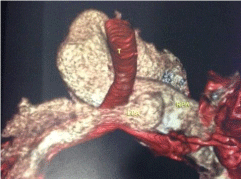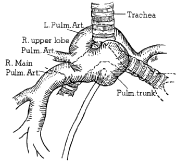
Case Presentation
Austin J Anesthesia and Analgesia. 2018; 6(2): 1070.
Pulmonary Artery Sling: Anesthetic Challenges and Fast Track Technique
Hilal Abdou AM*
Department of Anesthesia and Intensive Care, Ain Shams University, Cairo, Egypt
*Corresponding author: Amr M Hilal Abdou, Department of Anesthesia and Intensive Care, Ain Shams University, Cairo, Egypt
Received: April 24, 2018; Accepted: May 22, 2018; Published: May 29, 2018
Abstract
Pulmonary artery sling is a rare congenital heart disease; most of the anesthesiologists are not familiar with the Pathophysiological concerns of that disease. Airway obstruction and tracheal compression is the leading complication for the disease, in this report we will discuss some of the anesthetic problems and management for the surgical repair of this disease.
Keywords: Fast Track; Pulmonary Artery; Sling
Introduction
This is the first case of pulmonary artery (PA) sling with tracheal stenosis to be reported in our center, Ain shams University hospital for the past 10 years, although our experience with cardio-thoracic surgery started over 60 years, we still don’t have reported cases and formulated anesthetic technique for PA sling procedures. We are fully aware that this pathology is very rare and it could account for less than 1% of congenital heart diseases candidates for corrective surgeries [1]. Vascular rings are a nightmare for most of anesthesiologists as it is may affect the trachea causing tracheal stenosis and obstruction. The exact pathology of pulmonary artery sling is that the left pulmonary artery (LPA) arises from the distal origin of the right pulmonary artery (RPA), the LPA runs in a tortuous retro-tracheal location causing posterior compression on the trachea in the pre-carinal level (Figure 1).

Figure 1: Showing vascular sling of LPA posterior to the trachea (T) causing
pressure changes.

Figure 2: Chest CT scan showing stenosis of the trachea just above the
carina measuring 4.0mm.

Figure 3: Illustration of the pulmonary arterial bed in cases of PA Sling.
Review of the Case
2 years old, 10 kilograms, male infant presented with marked airway obstruction and repeated chest infection not responding to medical treatment, investigations revealed a PA sling with tracheal stenosis measuring 4.0mm (Figure 2), with complicated functional atrial septal defect (ASD). Surgical team decided to go for a definitive repair of the sling and relief the compression on cardio-pulmonary bypass. Airway management was crucial for fear of tracheomalacia, preoperative fiberoptic bronchoscope was irrelevant, chest radiographs revealed right lung consolidations and tracheal stenosis just above the carina as mentioned, but there were no signs or symptoms of severe airway obstruction or stridor, chest examination revealed bilateral inspiratory rhonchi and coarse Crepitations, sepsis markers as c-reactive protein were negative and no signs of active infection was present, Echocardiography revealed ASD measuring 4.9mm with normal pulmonary artery pressure besides the PA sling, other laboratory profile were unremarkable, so we decided to start inhalational induction and insert an armored tube size 4mm ID without difficulty and ventilated on a pressure support mode, P insp 12 and applying 5 Cm H20 PEEP, lung recruitment maneuver was needed after induction by ET tube suctioning, bronchodilators, and Dexamesthasone 2mg iv, ETCO2 is maintained 25-30 mmHg throughout the operation. Catheters were inserted in the left femoral artery 20G and right internal jugular vein triple lumen 5.5F ultrasound guided; assessment of the Superior vena cava is important prior insertion of neck lines for fear of SVC compression by the ring. Planning of early Extubation and fast track anesthesia advised us to maintain anesthesia on Atracurium 0.1mg/kg, Sevoflurane 2% and fentanyl 1mic/kg, upon staring the cardiopulmonary bypass temperature reduced to 24C, hemofilteration was done to reduce interstitial pulmonary congestion and maintain MAP over 50mmHg and urine output 1ml/kg/hr, colloid priming of the CPB by albumin 2% aiming to increase the oncotic pressure to avoid pulmonary congestion.
Surgical technique was uneventful by correction of the LPA and reinserted in the main pulmonary trunk in 30 minutes followed by ASD repair during a period of 15 minutes of arrested heart. The patient weaned from CPB smoothly on adrenaline 5mic/kg/min thermodynamically stable. Post bypass arterial blood gas showed Ph 7.45 Po2 105mmHg PCo2 44mmHg HCO3 20meq/L, serum lactate was 1.5mmol/L. Decision for Extubation has been confirmed, removal of the ET tube was done after full reversal of muscle relaxant, CPAP mask applied on 5Cm H2o, adequate ventilation maintained, chest auscultation revealed bilateral coarse Crepitations and absence of rhonchi. Post operative period in the ICU was uneventful with no respiratory complications, discharged from ICU after 1 day and sent home after 7 days.
Discussion
Pulmonary artery sling was first described by Glavecke and Doehle in 1897 [2] the pathology has been named by Conte in 1958 [3]. The congenital anomaly is very rare which causes several degrees of obstruction of different parts if the trachea starting from the right main bronchus, distal trachea and in small amount of cases the left main bronchus (Figure 3). That sling arises from the posterior part of the right pulmonary artery, traversing the right main bronchus, then loops posterior between the trachea and the esophagus, finally ends at the hilum of the left lung. Success of the surgical procedure is multifactorial depending on the associated tracheal lesions and complex congenital anomalies. Presence of diffuse tracheal stenosis, ring-sling complex; is present in nearly 65% of patients with PA sling [4], 50% of the cases are associated with congenital heart defects like in our case A.S.D, V.S.D, P.D.A, Left SVC, and tetralogy of Fallot [5]. Diagnosis of PA Sling is mainly done by transthoracic echocardiography which is a rapid and safe method of assessment, further description of the anatomical defect is done by multi-slice CT scan, one of the main concerns for anesthesiologists is the airway; therefore all infants should perform a diagnostic bronchoscopy to exclude tracheal stenosis secondary to compression by the vascular ring. Risk stratification for these cases depends on their clinical status of the respiratory system which may extends from mild to severe respiratory distress to occasional stridor. Any delay of the diagnosis of these symptoms may increase the mortality from the disease. Preoperative rigid bronchoscopy identifies the length and diameter of stenosis, involvement of the carina, or involvement of the tracheobronchus [6]. Involvement of the trachea may require thoracic surgical intervention and repair of the defect; from this idea we took into consideration the purpose of fast track anesthesia and early Extubation of our case in order to prevent prolonged intubation and further tracheal affection or tracheomalacia. In our case the surgical correction done was transection and ligation of the anomalous LPA from the origin with distal reanastomosis to the main pulmonary trunk anterior to the trachea, without any intervention in the trachea this procedure has been done on a beating heart on CPB, followed by A.S.D repair on an arrested heart. Identifying of the stenotic segment of the trachea via the CT Scan is extremely important for ET tube size, in our case the stenotic segment was distal just before carina rendering easy intubation, measures should be done to avoid or minimize the tracheal edema, specially at the stenotic segment such as intravenous steroids, uncuffed tubes, fixation of the ETT just beyond the vocal cords, the optimum tube of tube for these cases is the Cole non-cuffed Endotracheal tube (Silicon made), these kind of tubes was introduced by Anesthesiologist Frank Cole in 1945 using it was reported by Charles Mcleskey and his colleagues in 1977 in a case of PA sling with severe tracheal stenosis [7], due to several financial constrains in our country, this kind of tubes are not available so we used a reinforced armored tube non-cuffed ET tube. History of repeated chest infections and associated left to right shunting from the A.S.D with relative increase pulmonary overflow promoted the use of intraoperative PEEP, lung recruitment, Hemofilteration during CPB, increasing the plasma oncotic pressure by albumin 2% administered during the priming of CPB, eventually by early Extubation and fast track anesthesia followed by applying of the CPAP mask, in the past report in 1977 they delayed the Extubation for 18 hours hoping that the tracheal edema would be somewhat resolved by that time. Dexamethasone given intravenous intraopertively aids in the resolution of tracheal edema first reported by others on and colleagues [8], the idea of fast track anesthesia and early Extubation has been discussed with the surgical team and confirmed with a study done by Xiao yang Hong and colleagues in 2015 [9], who recommended early Extubation in the operating theater and application of noninvasive CPAP ventilation in the ICU after anesthetic recovery, we followed this protocol and achieved the best outcome for the case with 24 hours ICU stay without morbidity followed by discharge to the ward for follow up. This report illustrated our management for rare congenital heart disease pathology and the benefits of fast track or early extubation for these patients.
References
- Yu JM, Liao CP, Ge S, Weng ZC, Hsiung MC, Chang JK, et al. The prevalence and clinical impact of pulmonary artery sling on school-aged children: A largescale screening study. Pediatr Pulmonol. 2008; 43: 656-661.
- Glaevecke H, Doehle T. Ueber eine seltene angeborene anomalie der pulmonalarterie. Munchen Med Woechenschr. 1897; 44: 950-960.
- Contro S, Niller RA, White H, et al. Bronchial obstruction due to pulmonary artery anomalies. Circulation. 1958; 17: 418-423.
- Berdon WE, Baker DH, Wung JT, Chrispin A, Kozlowski K, de Silva M, et al. Complete cartilage-ring tracheal stenosis associated with anomalous left pulmonary artery: The ring-sling complex. Radiology. 1984; 152: 57-64.
- Backer CL, Mavroudis C, Dunham ME, Holinger LD. Pulmonary artery sling: results with median sternotomy, cardiopulmonary bypass, and reimplantation. Ann Thorac Surg. 1999; 67: 1738-1744.
- Oshima Y, Yamaguchi M, Yoshimura N, Sato S, Muraji T, Nishijima E, et al. Management of pulmonary artery sling associated with tracheal stenosis. Ann Thorac Surg. 2008; 86: 1334-1338.
- Charles H Mcleskey, Wayne Martin. Anesthesia for repair of a pulmonaryartery sling in an infant with severe Tracheal Stenosis. Anesthesiology. 1977; 46: 368-370.
- Otherson HB Jr. The technique of intraluminal stenting and steroid administration in the treatment of tracheal stenosis in children. J Pediatr Surg. 1974; 9: 683-690.
- Xiaoyang Hong, Gengxu Zhou, Yuhang Lium, et al. Management of pulmonary artery sling with tracheal stenosis: LPA re-implantation without tracheoplasty. Int J Clin Exp Med. 2015; 8: 2741-2747.